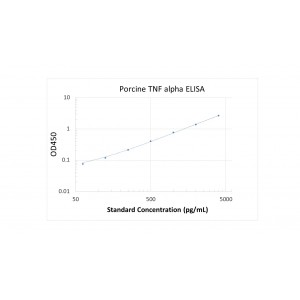Data sheet
| Alternate Names | APC1 protein; Cachectin; Cachetin; DIF; TNF; TNF, monocyte-derived; tnfa; tnf-a; TNFalpha; TNF-alpha; TNF-alphacachectin; TNFATNF, macrophage-derived; TNFSF1A; TNFSF2; TNFSF2TNF superfamily, member 2; tumor necrosis factor (TNF superfamily, member 2); tumor necrosis factor alpha; Tumor necrosis factor ligand superfamily member 2; tumor necrosis factor; tumor necrosis factor-alpha |
| Recovery | 91% to 102% |
| Precision | Intra-Assay, 5.3%; Inter-Assay, 9.6% |
| Gene ID | 397086 |
More info
|
Assay Range |
62.5-4,000 pg/mL |
|
Sensitivity |
5.0 pg/mL |
|
Specificity |
No cross-reaction with other related substances detected |
|
Size |
96T |
|
Storage |
Store at 2 - 8ºC. Keep reconstituted standard and detection Ab at -20 ºC |
|
Assay Principle |
Sandwich ELISA |
|
Sample Volume |
100 µL final volume, dilution factor varies on samples |
|
Sample Type |
Cell culture supernatants, plasma, serum |
|
Detection Method |
Colorimetric |
Kit Components
1. Recombinant Porcine TNF-a standard: 2 vials
2. One 96-well plate coated with Porcine TNF-a Ab
3. Sample diluent buffer: 12 mL - 1
4. Detection antibody: 1 vial
5.Streptavidin-HRP: 1 vial
6. Antibody diluent buffer: 12 mL x1
7. Streptavidin-HRP diluent buffer: 12 mL x1
8. TMB developing reagent: 10 mlx1
9. Stop solution: 10 mL x1
10. Washing solution (20x): 25 mL x1
Background
Tumor necrosis factor alpha (TNF-a), also known as cachectin, tumor necrosis factor and tumor necrosis factor ligand superfamily member 2, is a member of the tumor necrosis factor superfamily. Rat TNF-a is synthesized as a 26 kDa type II transmembrane protein that consists of a 35 amino acid (aa) cytoplasmic domain, a 21 aa transmembrane segment, and a 156 aa extracellular domain (ECD). Within the ECD, rat TNF-α shares 95% aa sequence identity with mouse TNF-a.TNF-a is assembled intracellularly to form a noncovalently linked homotrimer to be expressed on the cell surface. The membrane bound TNF-a can be cleaved by TACE/ADAM17 to release the bioactive cytokine, a 55 kDa soluble trimer of the TNF-a extracellular domain.
TNF-a binds to TNF RI and TNF RII to transduce its signals in target cells. Only TNF RI, however, contains a cytoplasmic death domain which triggers the apoptotic processes. Soluble forms of these two TNF receptors have been detected in human serum and urine and can neutralize the biological activity of TNF-a. TNF-a has exhibited potent activities in inflammation, immune system development, apoptosis, and lipid metabolism. TNF-a is also implicated in a number of pathological conditions including asthma, rheumatoid arthritis, neuropathic pain, obesity, type 2 diabetes, septic shock, autoimmunity and cancers.
Product Citation:
1. Assessment of coagulopathy, endothelial injury, and inflammation after traumatic brain injury and hemorrhage in a porcine model, Sillesen, Martin et al, Journal of Trauma and Acute Care Surgery: January 2014 - Volume 76 - Issue 1 - p 12–20
doi: 10.1097/TA.0b013e3182aaa675


